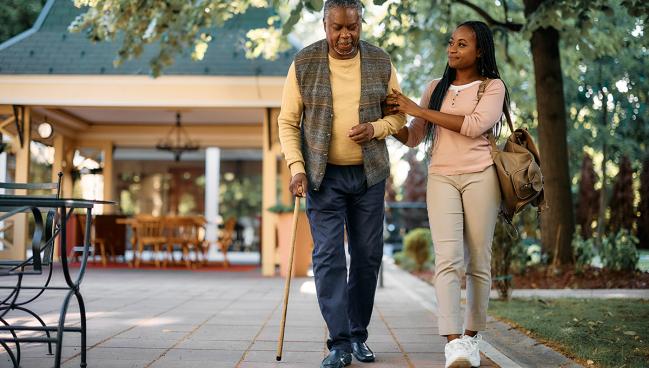Scientific Statement Reviews Current Antithrombotic Options in PAD
The document includes a variety of patient vignettes designed to make the material more relatable and memorable for clinicians.

Antithrombotic therapy in patients with PAD can be a challenge to manage, but a new scientific statement uses patient vignettes to help clinicians link treatment options with patient characteristics to help in the selection and personalization of optimal therapy.
Having a better understanding of how and why adverse events occur in PAD patients may help make antithrombotic choices more clear, the authors say.
“One of the biggest things this document does is highlight the mechanisms by which thrombotic complications happen. We have the artery-to-artery embolization, we've got plaque rupture, and we've got distal embolization. All of those mechanisms can be treated with antithrombotic therapy,” Geoffrey Barnes, MD (University of Michigan, Ann Arbor), a co-author of the statement, told TCTMD.
“So right away, it's saying antithrombotics are a central first-line part of the therapy,” he added. “The second thing it does is really pushes clinicians to move beyond antiplatelet therapy, which is where we have been for decades, and says there's more that we can do than simply giving every patient with PAD aspirin.”
Two clinical trials provided data on antithrombotic safety and efficacy in PAD that were driving forces in the treatment recommendations supporting dual-pathway inhibition versus standard of care: COMPASS and VOYAGER-PAD.
In the COMPASS trial, rivaroxaban (Xarelto; Bayer/Janssen) plus aspirin reduced the risk of CV death, MI, or stroke compared with low-dose aspirin alone in patients with stable CAD, a subset of whom also had PAD.
VOYAGER-PAD showed that a combination of rivaroxaban (Xarelto; Bayer/Janssen) and low-dose aspirin is superior to aspirin alone for the prevention of acute limb ischemia, amputation, CV events, and stroke in an all-PAD population. That study has further produced numerous subanalyses documenting less venous thromboembolism with the rivaroxaban and aspirin combination than with aspirin alone as well as safety in those with renal disease.
“Those two studies and all of the secondary analyses that have come out from those studies really help us understand how to use [antithrombotic therapy], what benefits to expect, what safety concerns we may have, and how to antiplatelet with the anticoagulant management,” Barnes noted.
Vignettes Illustrate Practical Applications
The scientific statement, published August 26, 2024, in the Journal of the American College of Cardiology and led by Marc P. Bonaca, MD (University of Colorado School of Medicine, Aurora), covers antithrombotic therapy and heterogeneity in patients with both CAD and PAD, reviews supporting evidence for antithrombotic therapies in patients with PAD, and contains several “Clinical Challenge” sections.
The latter are where the vignettes come into play, detailing specific patient examples. The first of these is in a section on risk stratification for antithrombotic therapy. Current guidelines give class I recommendations to three options: aspirin alone or clopidogrel alone, both of which have been shown to reduce MACE but not major adverse limb events (MALE), and combination low-dose aspirin and rivaroxaban, which can further reduce MACE and lower the risk of MALE but does increase the risk of bleeding. Two vignettes in this section offer medical therapy guidance through story examples of a female patient and a male patient with PAD and vastly different clinical profiles.
The second clinical challenge addresses managing antithrombotic therapy after lower-extremity revascularization (LER). Here, the guidelines give a class I recommendation to low-dose aspirin plus rivaroxaban 2.5 mg twice daily, but clinical translation in the context of dual antiplatelet therapy (DAPT) and selected use of full-dose anticoagulation can be challenge, the committee notes. In this setting, patients are at high risk of both bleeding and MALE. Again, the two clinical vignettes discuss medication options for very different patients: one undergoing a repeat endovascular LER and a patient with a nonhealing foot wound undergoing femoropopliteal bypass surgery using prosthetic conduit.
Among the options are DAPT and varying-intensity anticoagulation combined with antiplatelet therapy, with an explanation of patient-related factors that need to be considered if either of these strategies are chosen.
Additional vignettes describe challenges in managing antithrombotic therapy in patients with PAD undergoing nonvascular procedures, those presenting with acute limb ischemia, and those who have multiple indications for antithrombotic therapies at different doses and/or intensities.
Learners remember stories because they get interested in them, and that’s part of how our brain works to help us remember. Geoffrey Barnes
To TCTMD, Barnes said the scientific committee didn’t set out to include the vignettes. Instead, these grew out of discussions about how to make the material more accessible and patient-centered.
“We realized that using case vignettes would help clinicians see the practical applications of the guidance that is being provided here,” he added. “Using these vignettes that have some differing features allowed us to talk about the nuance of individual management strategies . . . and make them more relatable perhaps and [make you think] about how to apply this in your clinic or when you are about to discharge a patient.”
Barnes said there may be another advantage to the vignettes: the power of stories to help people learn and remember.
“Learners remember stories because they get interested in them, and that’s part of how our brain works to help us remember,” he said. “Case vignettes are patient stories [and they may] help move things into our long-term memory. I think this structure might actually work really well not just in making the information accessible for clinicians, but in helping them remember what they're reading so that they can apply it to their patients and their patients receive the benefits.”
Future Considerations and Good Stewardship
The final portion of the scientific statement addresses novel agents and strategies that are currently being explored. These include factor XI/XIa inhibitors aimed at selective inhibition of the contact pathway, which may help decouple thrombosis prevention and bleeding risk.
In addition, while there are data to support de-escalation of antiplatelet therapy and DAPT in patients with coronary disease to reduce bleeding risk, and data in ACS patients on adjunctive antiplatelet, anticoagulant, and fibrinolytic therapies, there is a lack of safety and efficacy data in these areas for patients presenting with chronic limb-threatening and acute limb ischemia.
Another place where guidance is needed and where the guidelines can help introduce more thoughtful discussion is in the discontinuation and resumption of antithrombotic therapies in PAD patients as they live with the disease and need additional interventional procedures, which a recent analysis from VOYAGER-PAD shows is a common scenario.
“This is where I think there's a great opportunity for us to develop good stewardship models within our health systems and say: we are going to own this to make sure that patients are not confused, to make sure we're communicating clearly about how to safely manage both the preprocedure piece . . . and when to restart those medicines afterwards, so that they can get back on the therapies that are meant to prevent complications,” Barnes suggested.
While some of those things may seem simple, Barnes said for patients it’s always best to spell things out clearly.
“If you tell a patient, I want you to stop your blood thinner 2 days before a procedure, there’s a good chance they don't understand what that means,” he added. “If the procedure is on a Friday, they may [wonder]: ‘Do I take the morning pill on Wednesday or no pills on Wednesday?’ The practical management is challenging, but this is [part of] good stewardship.”
L.A. McKeown is a Senior Medical Journalist for TCTMD, the Section Editor of CV Team Forum, and Senior Medical…
Read Full BioSources
Bonaca MP, Barnes GD, Bauersachs R, et al. Antithrombotic strategies for patients with peripheral artery disease: JACC scientific statement. J Am Coll Cardiol. 2024;84:936-952.
Disclosures
- Bonaca reports research grant/consulting funding to his institution from Abbott, Agios, Alexion, Alnylam, Amgen, Angionetics, Anthos Therapeutics, ARCA Biopharma, Array BioPharma, AstraZeneca, Atentiv, Audentes Therapeutics, Bayer, Better Therapeutics, Bristol Myers Squibb, Cambrian Biopharma, Cardiol Therapeutics, CellResearch Corporation, Cleerly, Cook Regentec, CSL Behring, Eidos Therapeutics, EPG Communication Holdings, Epizon Pharma, Esperion Therapeutics, Faraday Pharmaceuticals, Foresee Pharmaceuticals, Fortress Biotech, HDL Therapeutics, HeartFlow, Hummingbird Bioscience, Insmed, Ionis Pharmaceuticals, IQVIA, Janssen, Lexicon Pharmaceuticals, MedImmune Limited, Medpace, Merck, Nectero Medical, Novartis, Novo Nordisk, Osiris, Pfizer, PhaseBio, PPD Development, Prothena Biosciences, Regeneron, Regio, Sanifit Therapeutics, Sanofi, Silence Therapeutics, Stealth BioTherapeutics, VarmX, Virta Health, and WraSer.
- Barnes reports grants from Boston Scientific; consulting fees from Pfizer, and Bristol Myers Squibb, Janssen, Bayer, AstraZeneca, Sanofi, Anthos, Abbott Vascular, and Boston Scientific; being part of the Data and Safety Monitoring Board (DSMB) for Translational Sciences (Clinical Events Adjudication Committee); and has been a member of the Board of Directors - Anticoagulation Forum.





Comments